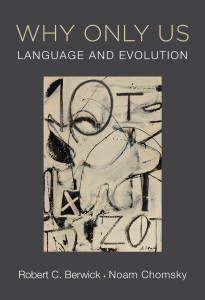 Noam Chomsky, giant of contemporary thought and inventor of transformational grammar and computational linguistics, has a new book out and it’s mercifully on linguistics, not politics.
Noam Chomsky, giant of contemporary thought and inventor of transformational grammar and computational linguistics, has a new book out and it’s mercifully on linguistics, not politics.
The core idea in his new monograph is that humans understand language hierarchically, an ability he and co-author Robert Berwick call “Merge.” Two mental objects can be merged into one, and that new, compound object can be processed linguistically as if it were a single object.
According to a review in The Economist (March 26th, 2016), a cat wearing a “hat” can become a “cat in the hat,” a noun phrase that functions grammatically as a single mental object. It can be merged with “the” to become “the cat in the hat,” and with other elements to become “The cat in the hat on the mat.” Whole sentences can in this way become single mental objects, as in “The cat in the hat on the mat came back.” Such compound mental objects can then be merged with other sentences to produce complex systems of thought.
Thus, language and thought are joined by this single ability, called “Merge,” which allows humans to think hierarchically. The gene for this hierarchical ability allows advanced thought, which confers evolutionary advantage so is conserved over generations.
Birdsongs are also a form of communication, but they are linear, not hierarchical. A sequence of notes, however complex, is rehearsed start to finish without folding, compounding, or hierarchical embedding. That’s why, despite having a language, birds can’t think. They lack the Merge gene.
Leaving aside the presumptive genetics, for which there is little or no evidence, the hypothesis reduces to, “Humans think hierarchically because language is processed hierarchically.” But we must allow that the causal arrow could run the other direction. Perhaps language is (or can be) processed hierarchically because we innately think and perceive hierarchically (e.g., due to Gestalt formation), not the reverse.
Those caveats aside, there is still a fundamental problem with the Merge hypothesis. “Cat” and “hat” are not free-standing mental objects, nor are any linguistic terms. Linguists, and most philosophers, labor under the illusion that there are such billiard balls of experience, each with attached linguistic label. My hypothesis is different: such mental objects are analytic products, generated post-experience, from social interaction.
My archetypal case study is Helen Keller learning the meaning of her first word, “water.” In her autobiography (The Story of My Life, 1902), she describes how, as a deaf, blind and mute child, her teacher held one of her hands under the water flowing from a pump, and worked the fingers of her other hand into the sign for water. In a magical moment, she writes, she suddenly understood the connection between the sign and the sensation, and language was born for her. This account was written by Ms. Keller years after the experience and after her college education, and it invokes Hume’s association theory of learning, as, no doubt, she was taught in school.
My intuition says the process was something different. She already had a deeply intimate relationship with her teacher, Anne Sullivan, who was with her virtually every hour of every day, when, on the day of the pump experience, Helen understood for the first time that Anne too, must be having, or had had, the very sensation of water that she was having. That is, she allowed that her private mental experience was not, after all, entirely private. Rather, her teacher, Anne, could, and did, also experience water, the very same sensation she was having at the moment. That was part one of the fundamental insight.
Secondly, as if proof of the first part, Anne was manipulating Helen’s fingers into a sign, using her own (Anne’s own) fingers to do so. They both had fingers. They both had finger-folding sensations. They both had water-on-the-fingers sensations. Conclusion: they were intersubjective; they almost literally shared mental experience. That was part two of the great learning, the great insight. It was a social learning, the most profound one anyone can have.
On that day, Helen learned that we people, you and I, with these experiences we now literally share, make this finger-sign whenever we have this other, watery finger-experience. The insight was realization of being a member of the club “we.” It was not the clang of Humean association. It was the thrill of realizing she was not alone.
Mental objects like “water” are differentiated out of prelinguistic social experience, and become compounded later through more complex social experience. Language is derivative of social interaction (as Wittgenstein convincingly argued). Words never stand as self-existent mental objects with their own reality the way numbers supposedly do.
The so-called Merge gene is thus not necessary. Humans do not have complex thought because they process language hierarchically. We process language hierarchically because our social interactions are fundamentally holistic from the beginning. Only later, with education, do we learn to analyze our complex, emotional, and prelinguistic social relationships into elements like words and conceptualized mental objects.
The nature of human creative thought is to project some aspect of experience out into the world, forget that we have done so, then “discover” that object and with an eerie sense of familiarity, say, “aha! I recognize this.” That’s exactly what Chomsky and Berwick done. They’re exactly half right.
Chomsky, Noam, and Berwick, Robert C. (2015). Why Only Us: Language and Evolution. Cambridge, MA: MIT Press (224 pp).
